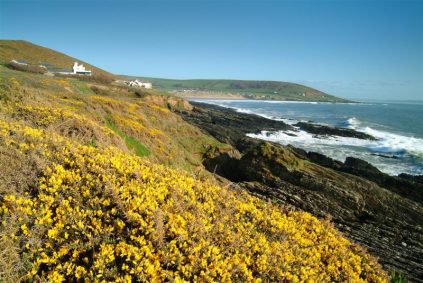Situated between the golden sands of Croyde and Putsborough beaches, gorse, heather, and coastal wildflowers adorn Baggy Point’s dramatic cliffs as it juts out into the Altlantic. A great place for walkers, the point is regularly frequented by rock climbers – not a sport recommended for the faint hearted or those that don’t know what they’re doing on these impressive rockfaces.
Nature and Landscape
Baggy Point hosts breathtaking scenery with views along the North Devon coast across the Bideford Bay estuary to Clovelly, Hartland and Lundy. Here you’ll find a classic coastal healthland habitat and can often spot hunting kestrels hovering above the cliffs. Spectacular scenery all year, Baggy Point is arguably at its best when adorned with summer colour.
Baggy Point is owned and traditionally managed through tenant farmers by the National Trust.
Baggy Point is a central area in the Saunton to Baggy Point Coast SSSI. Here, a combination of biological and geological features come to prominence. The complex geology of the site has yielded type specimens of rocks and rock formations, as well as one of South-West England’s most important sites for beach deposits.
The twin headlands of Baggy and Down End with the intervening Croyde Bay are made of 300-400 million year old (Upper Devonian) sandstone and slate layers. You can see how these are steeply dipping and folded on the exposed cliff faces. Originally formed in flat sheets as part of a muddy delta, the rocks were folded and up-ended by truly tremendous geological forces. This folding formed a majestic mountain chain which has long-since eroded away to form our far gentler present day landscape.
Arts and Culture
Baggy Point was an inspirational haunt of writer Henry Williamson (Tarka the Otter) – who once lived in nearby Georgeham.
Amenities
There is a small National Trust car park and tea room on the Croyde Bay side of Baggy, and a bus stop approximately 5 minutes walk from this car-park. There are bus stops in Woolacombe – enabling those who enjoy walking to walk between the two and catch a leisurely bus-ride back.
More information on the National Trust website.
History
In 1943 a series of dummy pillboxes were constructed when the promontory was used for coastal assault training by the US army. The training was in preparation for D-Day and on Baggy Point ten dummy pillboxes were built to represent enemy gun emplacements; seven of these survive.
Like much of our coast, Baggy is the resting place for many traditional sailing ships – caught out by strong southwesterly storms which dashed the ship and crew against the rocks below. One of the largest and possibly most famous of local ships lost here was the Ceres – the largest ship to sail out of Braunton’s Port – Vellator Quay.
Further back in time – the flint scatters and axe heads of Neolithic and Mesolithic hunter gathers reveal that Britain’s early, nomadic people made camp on Baggy Point as long as 7,000 years ago.
Activities
You’ll spot walkers, rock climbers, sea anglers and coasteering parties on this beautiful headland


